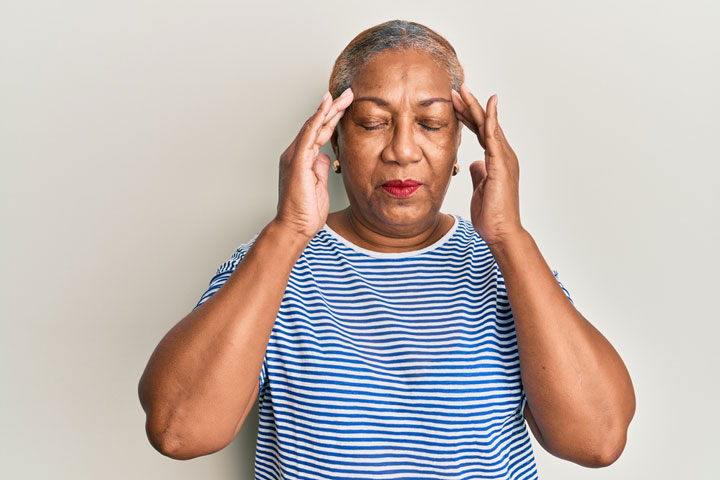Because of overlapping symptoms, diagnosis of a headache type can be a challenge. The nurse practitioner must also distinguish between primary headache, which, though painful, is not usually harmful, and secondary headache, such as subarachnoid hemorrhage or transient ischemic attack, which could lead to a stroke.
These red flags and types of headaches are part of a longer look at the assessment, diagnosis, and management of headaches, which can be found here.
Red flags from patient history
Red flags in the history require that further evaluation be done for secondary causes. Sudden onset of a severe, intractable headache may suggest an intracranial disorder such as subarachnoid hemorrhage or meningitis. Severe headache triggered by sexual intercourse, cough, or exertion may be caused by an intracranial mass or subarachnoid hemorrhage. New onset of headaches in persons older than 50, new onset of severe headaches during pregnancy or postpartum, or new headache types in patients with cancer or immunosuppression are of particular concern. Any headache described as the “worst headache ever” requires immediate attention.
Red flags from physical exam
Red flags in the physical examination include, but are not limited to, fever, weight loss, altered mental status, weakness, papilledema, focal neurologic deficits, proximal artery tenderness, and meningismus. All pertinent negative and positive physical exam findings, along with history findings, help to further differentiate between primary and secondary headaches
Types of headache
Migraine
Migraines present as severe, disabling, unilateral headaches often described as pulsating in nature. Symptoms may worsen with routine physical activity. Sensitivity to light, sound, and smells is often present, as are nausea and stiff neck. Some migraineurs describe having prodromal symptoms (e.g., drowsiness, restlessness, decreased concentration, gastrointestinal upset) that may last for hours to days before the migraine. Twenty percent to 30 percent of migraineurs experience an aura. Aura consists of fully reversible visual, sensory, or speech disturbances that develop gradually before the headache and that last no longer than 60 minutes. Despite all these symptoms, neurologic examination findings in patients with migraine headache are negative or normal.
Migraines are 2-3 times more common in women than in men and vary in severity. In females, prevalence of migraines diminishes after age 50 or after menopause unless estrogen replacement therapy is used.
Cluster headache
Cluster headaches usually occur at night and are severe and unilateral. Although cluster headaches have been found to be six times more prevalent in males than in females, more and more women — typically between ages 20 and 40 — are being diagnosed with this condition. Cluster headaches are frequently misdiagnosed as migraine, sinusitis, or allergies. The patient may describe sharp, unilateral orbital, supraorbital, or temporal pain accompanied by autonomic symptoms on the affected side (e.g., teary eye, nasal congestion or runny nose, ptosis, eyelid swelling, conjunctival injection). Unlike migraines, who prefer to remain at rest in a dark room, patients with cluster headache tend to be restless.
Episodes may last 15-180 minutes, and may occur once every other day to as often as 8 times daily. These headaches typically occur daily for several weeks, followed by a period of remission.
Tension headache
Tension headaches can be episodic (usually associated with a stressful event) or chronic (usually associated with muscular contraction in the neck and scalp). Definitive diagnosis includes two of these traits: pressing or tightening pain; occipitofrontal location; bilateral pain, with mild to moderate intensity; and lack of effect of physical activity. These headaches are typically self-limiting and non-debilitating and have no associated symptoms. Physical exam findings are normal.
Chronic daily headache
This type of headache occurs on 15 or more days per month for at least 3 months and is typically related to medication overuse, although it may represent chronic (transformed) migraine. Medication overuse headache results from taking acute headache medication for 2-3 days per week. Transformed migraine is a constant (24-hour) headache with intermittent, superimposed migraine symptoms. As many as 80 percent of patients with transformed migraine have coexisting depression.

